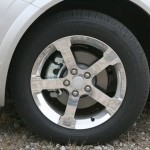 With tyres being the only contact points between your vehicle and the road surface, it is vital that you, as a motorist, are aware of the condition of your tyres and how to properly care for them. Although tyres are effectively disposable items that will need replacing at some point, they can be extremely expensive, so it is in your best interests to make sure they last as long as possible, but how do you make your tyres last as long as possible?
With tyres being the only contact points between your vehicle and the road surface, it is vital that you, as a motorist, are aware of the condition of your tyres and how to properly care for them. Although tyres are effectively disposable items that will need replacing at some point, they can be extremely expensive, so it is in your best interests to make sure they last as long as possible, but how do you make your tyres last as long as possible?
Tyre treads are made out of natural and synthetic rubber. Rubber tyres will always wear down as you are driving, and while this is unavoidable, it is possible to prolong the life of your tyres by trying to reduce the wear rate. In simple terms, this means avoiding breaking traction by wheelspin, skidding or cornering too fast. Driving within the traction capabilities of the tyres will mean they will wear at a much slower rate.
As every experienced driver knows, occasionally there comes a time when you either drive through a pothole, or drive up a curb stone too harshly and you feel the shock reverberate through the cabin of the vehicle. While you give a little sigh and carry on, you may not be aware that there is a good chance that every time this happens it modifies the suspension geometry, specifically the wheel alignment. Wheels that are not perfectly aligned will cause uneven tyre wear generally on the inside shoulder of the tyre. If you feel the car is not able to drive in a straight line without your guidance, have a mechanic check the wheel alignment on your behalf.
Tyre pressure is another area that you should be aware of. In fact, one of the most important checks you should do before driving your car is the tyre pressure. If your tyres have less than the recommended pressure of air in them, they will perform particularly badly in terms of handling, and also they will wear quicker, generally on the outside edges of the tyre. If your tyres are pumped up above the recommended pressure, then there may be less rubber in contact with the ground and the center of the tyre will wear quicker.
Some more factors that you need to be aware of are damage and age. Rubber will perish with age, and all tyres have an advised age limit of around 6 years, regardless of how many miles they have covered. Also, you should regularly check your car’s tyres for damage in the form of gouges or bulges. A large bulge shows that the structural rigidity of the tyre has been compromised and it could potentially result in a blowout, possibly during driving. A gouge would obviously also compromise the rigidity of the tyre, possibly causing an accident. If you notice either of these, or any other damage, cracks, deep cuts or severe abrasions, have the tyres replaces as soon as possible.
Article from: http://uberarticles.com/automotive/car-tyre-care-and-maintenance










